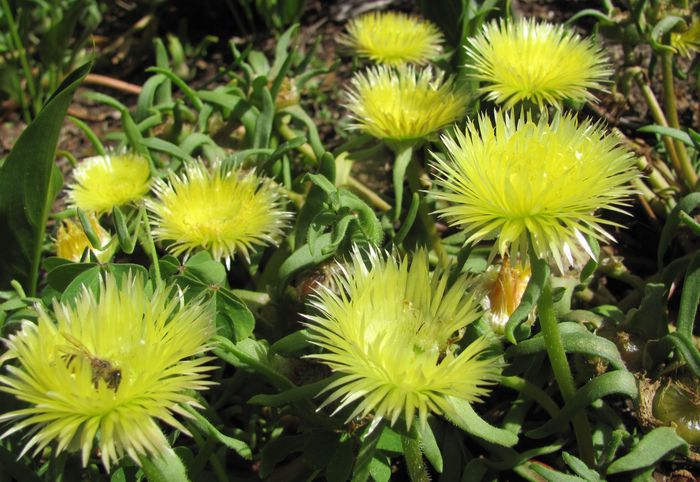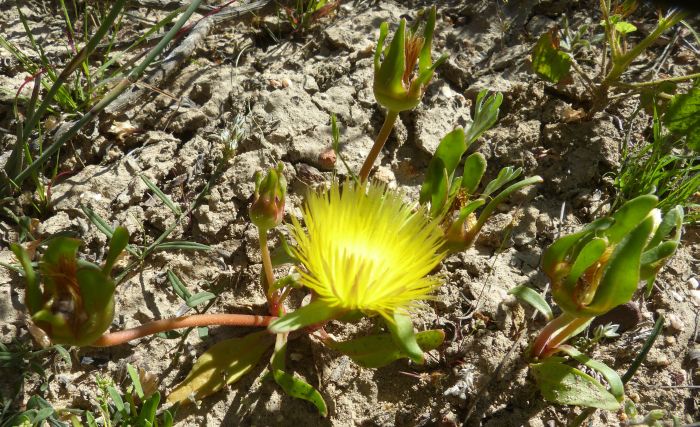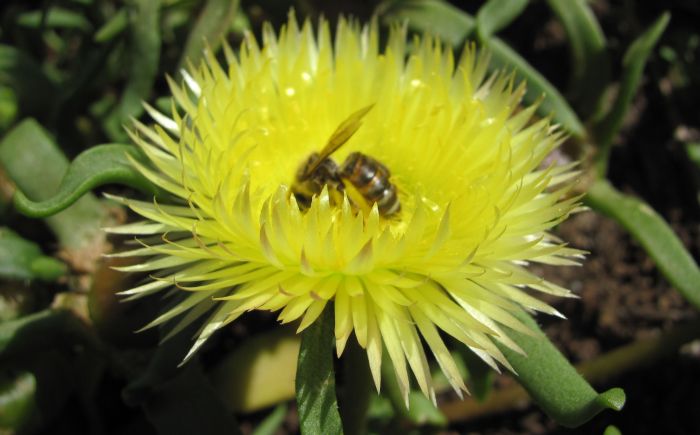Carpanthea pomeridiana
Carpanthea pomeridiana (N.E. Br.) L.
Family: Aizoaceae
Common names: carpanthea (Eng.); vetkousie (Afr.)
Introduction
Carpanthea pomeridiana is an easily propagated, fast-growing annual, endemic to the sandy coastal regions of the Western Cape. It has golden-yellow flowers in spring, succeeded by rounded, woody, multi-locular capsules. It grows in Strandveld and Coastal Fynbos and grows well as a garden annual, sown in autumn. The young fruits are edible, especially when prepared in a stew in the same way as Aponogeton (waterblommetjie).

Description
Description
Carpanthea pomeridiana is a rapidly growing, hairy, annual, leaf succulent with a spreading, decumbent growth habit. Branches are reclining, hairy to sparsely hairy, reaching a height of 150–300 mm and with a spread of 200–300 mm. The roots are fibrous. The lower main stem grows about 5 mm in diameter, the upper stems terete, 2–3 mm in diameter. The leaves are in opposite pairs, horizontal to ascending, softly succulent, flat, united at the base, and are spoon-shaped to spear-shaped, 3.5–10 × 10–25 mm; the petiole channelled at the base, light green; the leaf margin minutely ciliate. The leaf end is acute to blunt (obtuse) to subacute.
The flowers are produced terminally, 1–3 on long pedicels, 40–170 mm long; the floral bracts 20–50 × 30–70 mm. The flowers in cymes, are rich golden-yellow and about 40–70 mm in diameter. The sepals are unequal with 2 of them leafy. Petals dense, in many series, these are linear, pointed and silk-like. Stamens plentiful, at first inflexed and later becoming spreading, exposing the stigmas. The ovary is inferior, the placentas basal, 12–20 and filiform, pointed. The fruit (receptacle) is flat, bowl-shaped and 15–20 mm in diameter and 10 mm deep. When dry hygrochastical, opening with moisture, releasing the small seeds. These are roundish angular, black, 1,5 mm in diameter, the epidermis minutely papillate.

Conservation Status
Status
Carpanthea pomeridiana was once common on the Cape Flats, but because of urban expansion, is becoming rare. It is still common along the West Coast, and is assessed as Least Concern (LC) in the Red List of South African plants.

Distribution and habitat
Distribution description
Restricted to the soft sandy coastal regions of the summer-dry Western Cape, from Langebaan to the Cape Flats, also with outliers in sandy regions near Worcester in the Breede River Valley. Always confined to open areas in full sun, in a flat terrain or on dunes, in soft sand, sharing its habitat with other spring annuals, such as Cleretum bellidiforme (= Dorotheanthus bellidiformis), Hymenogyne glabra and Apatesia helianthoides. It grows in the Strandveld Biome and especially common along the West Coast. Plants germinate in autumn, when the day lengths shorten and with the winter rainfall. They are rapid growing, flowering in spring, from September to November. During the month of November, the plant dries out and the capsules await the next rain to repeat the cycle.
This region is semi-arid with frontal winter rainfall of about 250–400 mm per annum and from April to October (growing season). Summers are long, dry and windy when the plant remains dormant, as seed. It is, thus, a drought evader. Summer temperatures can rise well above 30ºC.
The geology consists mainly of sand derived from the nutrient-poor quartzitic sandstone of the Cape Supergroup.
Derivation of name and historical aspects
History
Carpanthea was established by the botanist N.E. Brown in the Gardeners Chronicles, in 1925. The name is derived from the Greek karpos, meaning ‘fruit’ and anthe or anthos, meaning ‘flower’, referring to the edible young fruits (Clark & Charters 2016). This species was first named by Carolus Linnaeus as Mesembryanthemum pomeridianum. The name pomeridiana is derived from the Latin post meridiem meaning ‘past midday’ or ‘in the afternoon’, referring to the way the flowers open from midday.
The common name vetkousie (meaning ‘fat socks’), pertains both to its fleshy fruit and is said to represent a corruption and translation of the Khoi name.
Carpanthea belongs to the subfamily Mesembryanthemoideae, including the annuals and rapid growing species. Only one species is known, C. pomeridiana, characterized by its golden-yellow flowers and multilocular capsules, opening only with moisture.

Ecology
Ecology
Rapidly growing annuals, germinating in autumn, growing in winter and flowering in spring, dying back in early summer, leaving seed capsules ready to disperse the seeds from the end of October to January. The distinctly flattened leaves are an adaptation to their cool, moist growing season. It grows in Strandveld and coastal Fynbos (Mucina & Rutherford, 2006), sharing its habitat with shrubs such as Zygophyllum morgsana and Z. flexuosum, Searsia lucida, S. glauca and S. laevigata and Euclea racemosa. Associated succulents include Cotyledon orbiculata, Tylecodon grandiflora and T. paniculatus, Crassula nudicaulis and C. expansa, Euphorbia marlothiana, E. mauritanica and E. burmannii, Jordaaniella dubia and Ruschia macowanii.
The fruiting capsules are usually produced on the perimeter of the plant, often flat on the ground. These are hygrochastical (opening only with moisture and closing again when drying out). The expanding keels push open the cell lids and the seeds, which are without covering membranes, are splashed out by rainwater and dispersed locally around the mother plant, by falling rain drops. This ensures that it stays within the safe habitat.
The plant flowers profusely in spring, when the plants become very attractive. The open flowers are pollinated by bees, the flowers protrandric, which means first the stamens ripen allowing bees access to the pollen. Only after the stamens bend back, will the stigmas reach maturity, thus preventing self-pollination.

Uses
Use
A very useful edible plant formerly eaten by the Koi people, and by the colonists on the Cape Peninsula and Cape Flats. The young fleshy capsules are eaten as a lettuce or prepared in a stew. Collect the young fleshy fruits, boil and add to meat dishes. Vetkousie is also a popular garden annual, providing a show of golden flowers in spring.
Growing Carpanthea pomeridiana
Grow
The vetkousie is an easily grown annual, suitable for coastal winter rainfall gardens, as well as difficult windy seafront gardens. Best to sow in autumn. The plant grows rapidly and will flower in the coming spring, providing a magnificent show of yellow flowers. However, away from Mediterranean-type climates or in colder areas, it would be best grown in containers, in a sunnny greenhouse or on windowsills, where it can be protected from excessive rain or low temperatures. It is well suited for Strandveld, Fynbos and Succulent Karoo gardens (Van Jaarsveld 2010).
Propagate from seed sown in situ or in shallow seed trays. Crush the dried fruiting capsules to remove the seeds and sow in autumn, in sandy soil. Scatter seeds and cover with a thin layer of sand (1–2 mm thick). Water well and keep moist, or wait for the oncoming rains. Germination is rapid after a week or three (when seed is viable). Prick out the seedlings into flower beds or containers when large enough to handle. Once they have finished fruiting and the plants have dried, the fruiting capsules can be stored in a paper bag, in a cool, dry place, ready for the next autumn.
References
- Clarke, H. & Charters, M. 2016. The illustrated dictionary of southern African plant names. Flora & Fauna Publications Trust, Jacana, Johannesburg.
- Hartmann, H.E.K. 1991. Mesembryanthema. Systematics, biology and evolution of some South African taxa. Contributions from the Bolus Herbarium. No. 13: 75–157.
- Hartmann, H. 2001. Aizoaceae A-E. In Eggli, U. & Hartmann, H.E.K. (eds.) Handbook of succulent plants. Springer, Heidelberg, New York
- Herre, H. 1971. The genera of the Mesembryanthemaceae. Tafelberg, Cape Town.
- Mucina, L. & Rutherford, M.C. (eds) 2006. The vegetation of South Africa, Lesotho and Swaziland. Strelitzia 19. South African National Biodiversity Institute, Pretoria.
- Van Jaarsveld, E.J. 2010. Water wise gardening. Struik, Cape Town.
Credits
Ernst van Jaarsveld
Kirstenbosch National Botanical Garden (Retired 2015)
Babylonstoren Farm
Extraordinary senior lecturer and researcher,
Department of Biodiversity and Conservation, University of the Western Cape
May 2019
Plant Attributes:
Plant Type: Bi/Annual, Succulent
SA Distribution: Western Cape
Soil type: Sandy, Loam
Flowering season: Spring
PH: Acid, Alkaline, Neutral
Flower colour: Yellow
Aspect: Full Sun
Gardening skill: Easy
Special Features:
Horticultural zones








Rate this article
Article well written and informative
Rate this plant
Is this an interesting plant?
Login to add your Comment
Back to topNot registered yet? Click here to register.